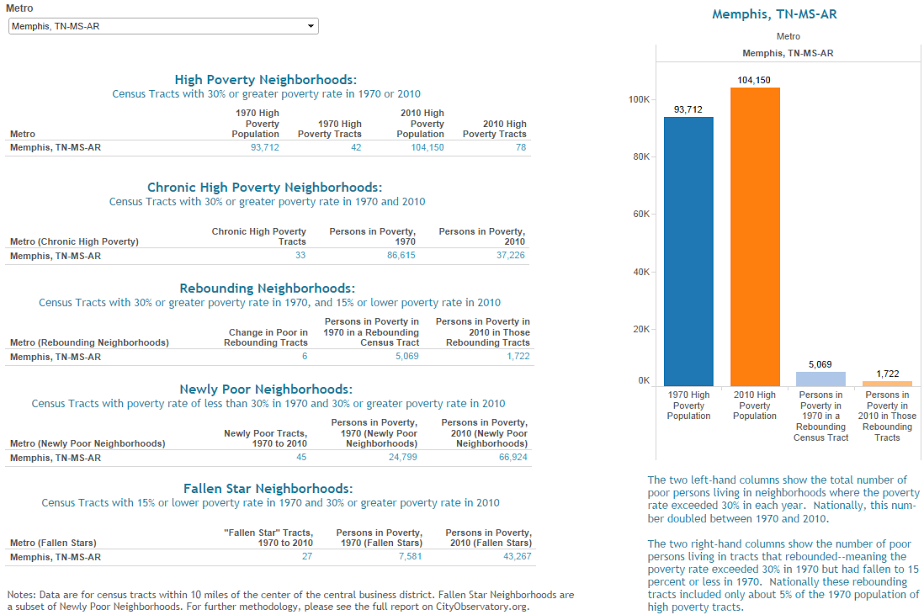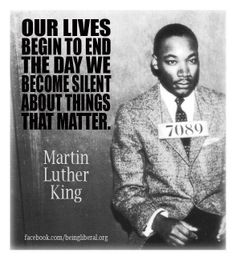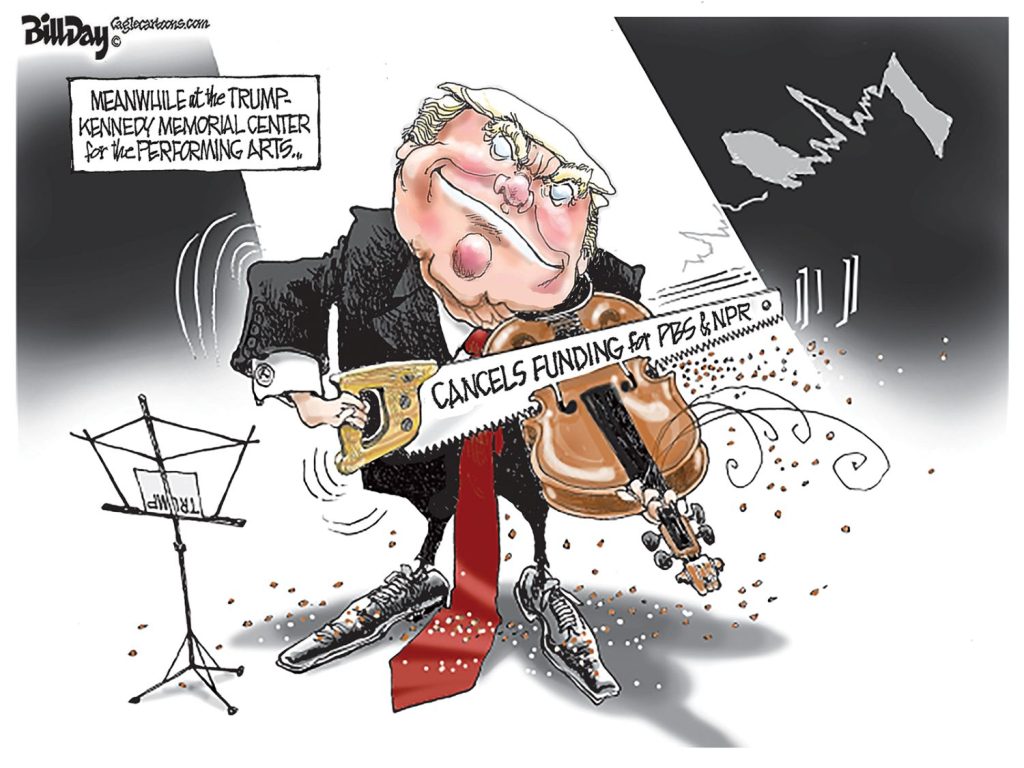Memphis should be so lucky as to have a gentrification problem.
If it did, it would indicate that people are moving back into Memphis core neighborhoods and that confidence in the city’s future is rising.
But while the “g word” gets more attention and attracts more angst, it’s the “p word” that deserves our focus and our concern – poverty, specifically, concentrated poverty.
For us, the recent gentrification map by Governing magazine underscored the absurdity of the level of alarm that’s brought to this issue. Its prime examples of gentrification in Memphis since 2000 include Uptown, a downtown area from Foote Homes to Shelby County Jail, EDGE/Medical Center, Soulsville, and Sherwood Forest. For 1990 to 2000, the prime example is Harbortown.
It’s The Poverty, Stupid
It’s reminiscent of the academic paper a few months ago that concluded that the biking culture here was a contributor to inequality and gentrification. That article felt more than anything like a conclusion looking for a justification, referring hyperbolically to Memphis’s “bicycling boom” although bikers amount to about .2% of population and to the “massive increase in bicycling infrastructure…(which) contribute to racialized gentrification.”
Like Governing, the authors fundamentally misunderstood the data within the context about South Main’s revival, and drew the assumption that if more people moved into South Main, they were displacing people with lower incomes.
In December, Joe Cortright’s City Observatory report looked at the 51 largest metro areas, including Memphis. He mailed: “We challenge frequently repeated narratives about the extent and impact of gentrification on urban poverty. Tracking change through shifts in poverty rates, the report shows that there have been remarkably few instances nationally of gentrification in which previously high poverty neighborhoods have seen their poverty drop to below the national average.
“Far more common has been the persistence and spread of concentrated poverty. Three-quarters of 1970 high poverty neighborhoods are still high poverty today. And the number of urban neighborhoods with poverty rates over 30 percent has tripled, and the number of poor living in these neighborhoods has doubled since 1970. This is alarming because a large and growing body of evidence confirms the devastating effects of living in and growing up in high poverty neighborhoods.”
Stability of Poverty Neighborhoods
In addition, the report spoke directly to the fallacies of the Governing article and the bicycle boom report with this comment: “It’s often argued and widely believed that the movement of higher income people into low income communities invariably produces one-for-one displacement of current poor residents. Our data show this gentrification narrative is misleading: precious few poor urban neighborhoods have rebounded, and those that have seen declines in poverty have recorded net increases in population. In contrast, high poverty neighborhoods that have seen declines in poverty have recorded net increases in population.”
As for Memphis, between 1970 and 2010, the number of high poverty neighborhoods climbed dramatically from 42 to 78 census tracts. Meanwhile, the population living in those census tracts increased from 93,712 to 104,140.
In other words, while the number of high poverty census tracts almost doubled – 87%, the population only increased 11%. It speaks to the historic level of migration out of Memphis neighborhoods, lured by the policies of county government that propelled sprawl and essentially required Memphians to pay for the decay of their own neighborhoods.
Massive Migration
Meanwhile, neighborhood infrastructure that was already paid for was abandoned as new roads and schools enticed more and more people from within the 1970 city limits of Memphis and county debt and maintenance costs climbed. In a presentation to Memphis City Council this week on plans to revive some inner city neighborhoods, architect Ray Brown pointed out that in the neighborhoods, 50% of the lots are now vacant and that doesn’t even include the houses that are vacant.
It speaks to the massive loss of property tax revenues in Memphis neighborhoods that took place as 169,827 people moved outside the 1970 city limits of Memphis between 1970 and 2013. In other words, the equivalent of the population of Chattanooga moved outside of the 1970 city limits of Memphis.
Here are the numbers: The population of 1970 Memphis was 619,757, but by 2013, the population within those 1970 city borders was 449,930, a decline of 27%.
Knowing that hindsight is 20-20, it’s hard not to see the absurdity of the lack of action that characterized an era when the city was deteriorating in such a fundamental way, mostly due to building new developments outside Memphis and disguising them as “growth.” What we needed was a very specific strategy of interventions in neighborhoods that could make them more appealing for new investment.
It can be done now if we pick the neighborhoods where there are still some strengths and/or assets to build on and start there. But then again, it’s hard to even tackle this without a real, functioning planning department like all of our peer cities.
Memphis’s Fallen Stars
But we digress. Back to gentrification.
“The result of these trends is that the poor in the nation’s metropolitan areas are increasingly segregated into neighborhoods of concentrated poverty,” the City Observatory report said. “These high-poverty neighborhoods were not stable – in the aggregate, they lost population, with chronic high-poverty neighborhoods losing 40% of their population over four decades.”
In fact, the report said, the growth in the number of poor people in “fallen star” neighborhoods dwarfs the decrease in the poverty population in the “rebounding” neighborhoods.
Fallen star neighborhoods are census tracts with 15% or lower poverty rates in 1970 and 30% or greater in 2010. Memphis had 27 fallen star census tracts. Their population in 1970 was 7,581, but by 2010, it was 43,267.
Rebounding neighborhoods are census tracts with poverty rates of 30% or more in 1970 and which had poverty rates of 15% or lower in 2010. There were six of these census tracts, but their population had fallen from 5,069 to 1,722.
Mythic Memphis
Other economists like Mr. Cortright are confirming his conclusion: that there is no evidence that poor people moved out of gentrifying neighborhoods at a higher than normal rate. More to the point, gentrification, as defined by the displacement of low income African American families by well-off Caucasians, is essentially a myth. In fact, the socio-economic profile of a neighborhood is remarkably stable over time.
As one commentator said: “The problem isn’t so much that gentrification hurts black neighborhoods. It’s that it too often bypasses them.”
About the City Observatory report, Brookings Institution wrote: “Gentrification certainly comes with attendant dangers for low-income families, which policy makers should be on guard against. But it comes with potential benefits too, so we should be careful about simply ‘protecting’ neighborhoods from the process. Policies and regulations that insulate impoverished neighborhoods from gentrification could end up condemning these communities to yet another generation of deep poverty and segregation.”





Wow! This article is truly depressing.
No doubt that Memphis is in a steep and serious decline.
Poverty.
Crime.
Population in decline.
Migration away from the city.
Anemic economic development.
Small city airport with only 70 passenger flights per day.
Small minded, backward leadership.
The doomsday predictions seem right.
Memphis is in serious trouble.
There is very little gentrification in Memphis compared to other cities. Gentrification and development always avoids areas of poverty, blight and crime.
Poverty is both widespread and highly concentrated across all of Memphis.
Excellent article here.
I must fall back on my mantra here on this site: far too much sprawl. Why should a developer invest in reviving a neighborhood when he can buy land much cheaper way out in the county and get the local gov’t to pay for the utilities to support it? Then demand wider roads to accommodate the increased traffic. The glut of space/land has caused this problem.
If building in the rural areas was cost prohibitive, then developers would have bought properties in the inner core, tore them down and developed them. There is some of that happening in downtown Memphis, but it needs to happen all over the city.
Imagine a walkable “town center” – like Elvis Presley Blvd. A revived and urban Frayser or North Memphis.
Instead, these areas were/are left to rot and pray for some proper private investment that will not come without gov’t investment
WCN:
Perhaps our developers are always years behind trends. Across the country, the area with dramatic growth, especially among young professionals, are the neighborhoods within three miles of downtown. It’s quality of place that matters, and Memphis has affordability and could have quality of place by investing in neighborhoods, including North and South Memphis, that attracts today’s young adults.
You are so right – city neighborhood development could have been incentivized by public policies (particularly those by county government) which instead fed sprawl which increased the cost of public services. Put simply, we have too few people living on too much land. Those walkable town centers would be a start toward the city we want, and perhaps, along the way, we can consider ways to reduce the land area as well.
@ Smart City
There is a new trend of “gentrification” (“urbanization”) that has now entered the suburbs of many cities. Bedroom communities are starting to be transformed into urban town centers. One of the most recent successful examples is Reston, VA. There are others like it across the country that are moving away from the 1950s style suburb and toward density, transit oriented development and smart design where homes are on the same block – or even in the same building – with commercial establishment and close to public transportation.
[As a side note, we may start to see such urbanization in Germantown, first, then it will spread into Memphis. Barlett also needs to do it for their long term health as well. But that is a different issue]
This is the type of investment that needs to be made in Memphis’ inner core.
GOP “I built that” rhetoric aside, developers follow the lead of the local government in investment. Where the local gov’t leads, the developers will follow. The problem in Memphis is that the local gov’t is following the lead of the developers.